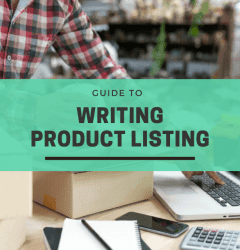This website uses cookies so that we can provide you with the best user experience possible. Cookie information is stored in your browser and performs functions such as recognising you when you return to our website and helping our team to understand which sections of the website you find most interesting and useful.
16 Jul

Guide to Bidding on Amazon Ads
After deciding on the structure of your ad campaigns, the next step here is to have a data-driven bidding strategy for your sustainable and profitable business. We will be taking a closer look at the way Amazon bidding strategies are designed to function.
With this piece, we will look at the basics of Amazon bidding strategy, ways of targeting, and the difference between types of bidding strategies. Next we will look at the levels at which you can play around your bids – placements and keywords, and finally the special occasions to consider.
Let’s jump right into it!
About Amazon Bidding
This main agenda for having your Amazon bidding strategies in place is to have a long-term profitable business coming from the world’s largest online retailer. And since the Amazon algorithm works on an auction basis, you need to have a strategy in place to stay ahead of the competition.
It starts with setting your overall account budget and the expected results. The central gist of deciding which Amazon bidding strategy to choose depends on how strong a foundation you have in tracking all the costs that include the commission charges and the charges for Advertising cost of Sale (ACoS).
Once you are able to calculate the actual cost of advertising you will be able to understand the actual profit that your advertisements are generating.
Though ACoS gives a basic understanding of how much one spends against what they have earned, it fails to give a clear picture. Hence, one can use TACoS, which is basically the Total Advertising Cost of Sales. Calculating this gives a much clearer picture of the total advertising spent relative to the ROI generated through running those advertisements.
The formula that you use to calculate the TACoS is:
TACoS = Advertising spend/Total revenue * 100
Types of Targeting
Automatic Targeting: As a brand, it is highly likely that you have more than one product that will be displayed on Amazon. In cases like this what happens under automatic targeting is that Amazon itself will decide which product it wants to display and not to which customer basis the keyword used by them.
When you are working on advertisement groups, it is advised that you limit the number of products that you have per ad group. This will ensure that your closely grouped products will get more visibility under the automatic targeting.
Manual Targeting: Targeting under the manual targeting actually gives the advertisers more control over the bids and the amount they spent on them. Under the manual targeting, you are free to bid for a certain ad group or for a keyword. It is always advisable to bid on the keyword level because it assures more visibility and give you a clear idea of which keywords are working for you.

Types of Amazon Bidding
The best thing about Amazon bidding strategy is that there are 3 different types of bidding strategies that you can choose from based on the type of control you need. They are:
Dynamic bids – Down only: This kind of bidding is applicable only in the case when a click is unlikely to convert into a possible sale. When this happens the bid is reduced to 100%.
Amazon Dynamic Bid – Up and Down: In the case when a click is highly likely to convert, Amazon raises the bid to 100% for placing your ads at the top of the first page where search results are displayed.
Fixed Amazon bids – In this kind of Amazon bidding strategy, dynamic bidding is deactivated due to which the default bidding system is used which has been pre decided and set by you.

Bidding at the Placement Level
Another area where you can play around with your bids is at the placement level. There are 2 placements that Amazon offers to further adjust your bids. They are:
Top of the search page (1st page): In this kind of bidding, settings are offered based on the placement, so you can enter a percentage depending on how much you can spend. This particular spot is the most competitive advertising spot on Amazon. This place is reserved for all those who are the highest bidders.
The product pages: These bids place your ads on sponsored product pages and have nothing to do with search results. Most of the products that are displayed on product pages see more results than the remaining placements.

Bidding at Keyword Level
When you look at the different Amazon bidding strategies, the one that makes most of the difference is the keyword-level bidding.
Usually in an auction scenario, the person bidding the highest amount wins. However, the difference with Amazon bidding is that – although the seller who bid the highest amount for the keyword wins, but the amount that he needs to pay is what the second-highest bidder had bidden.
There are 3 different types of bids that one can opt for:
Ad groups that have both manual and automated targeting have to pay when customers click on their link from a given ad group. Bids of this kind are known as Default bids.
Suggested Bids are those bids that are displayed based on what the other advertisers have bid on. They display bids from those players who deal in the products that are similar to the ones that you are displaying. The winner of the bid is calculated on the basis of the other winning bids that are similar to your category.
The third way is through Custom bids. Here you can bid a higher amount in the start, evaluate its performance and then customize as per the need.


One reason why keyword targeting is so important is because under keyword targeting there is a strategy which is the Negative keyword targeting that helps control spends on those keywords that bring in no revenue as such. This is what makes the negative keyword targeting also a very crucial aspect of Amazon bidding strategies.
Special Occasions to Consider
Certain days like the Prime Day and other major sales days like Black Friday and Cyber Monday need to be given considerable planning. When planning out special days like these, it is important to know that Amazon’s automated bidding systems can’t handle the volume of bidding. Bids for these special days need to be carried out manually and they more or less depend on the products that were sold maximum the previous year.
Based on this, one may have to pay a higher bid value, if you are selling products that are fast moving products on these special days and events. One thing to keep in mind on these special days is that automatic bidding won’t work. A few important factors you need to consider before displaying your products on high volume days like this are the inventory, special deal prices and your ACoS.
Manual bidding works slightly differently compared to the other automatic bidding. In manual bidding, the seller manually decides the keywords and the rates of the bid. Based on the keyword match reference the product ads are then displayed In the manual bidding the target audience is more refined, and they help you achieve your target ACoS and maximize your product sales.
Tips to Choose the Correct Bidding Strategy for your Product
In order to gauge which bidding strategy will work best for your product type, it is advisable to use Amazon’s AI powered algorithm. For this, it is imperative that you collect previous data collected from your earlier campaigns so that Amazon’s AI algorithm can function correctly. This will give you relevant suggestions on which Amazon bidding strategy to choose for your product.
It is not easy to take down and comprehend all these details at once, after all, there are so many nuances to getting the right Amazon bidding strategy. Lucky for you all, you have all the important information under one domain right here. There will be a lot of trial and error before you understand the different Amazon bidding strategies and decipher which one suits you best, but if done correctly right from the start, you will surely get success.
Related Post
Industries Served
United States
India













